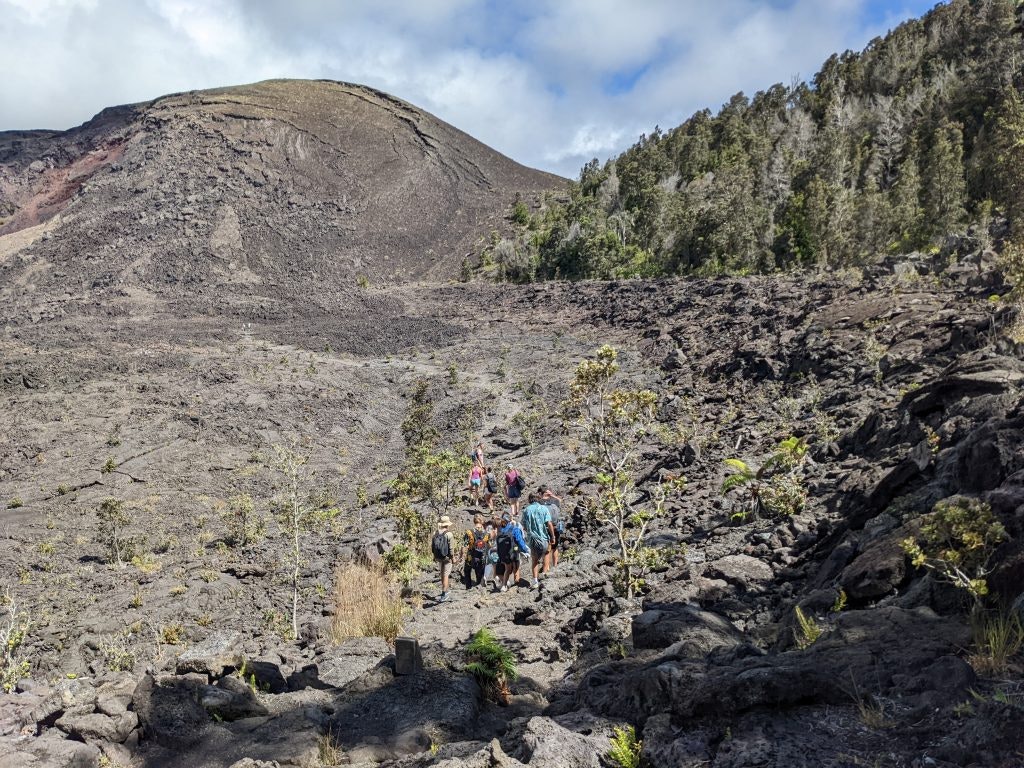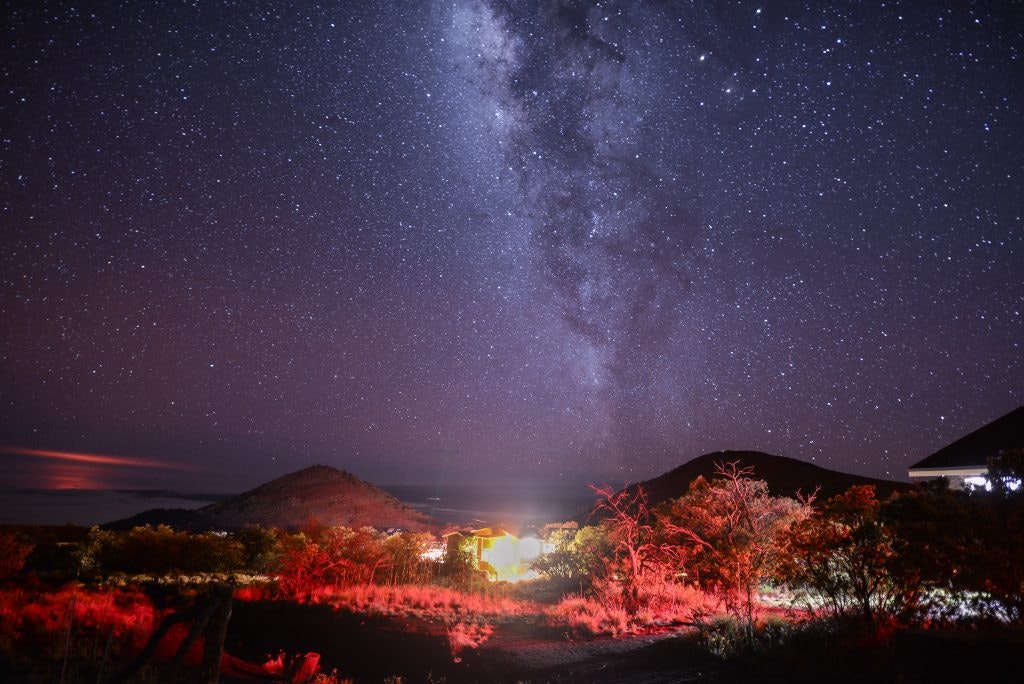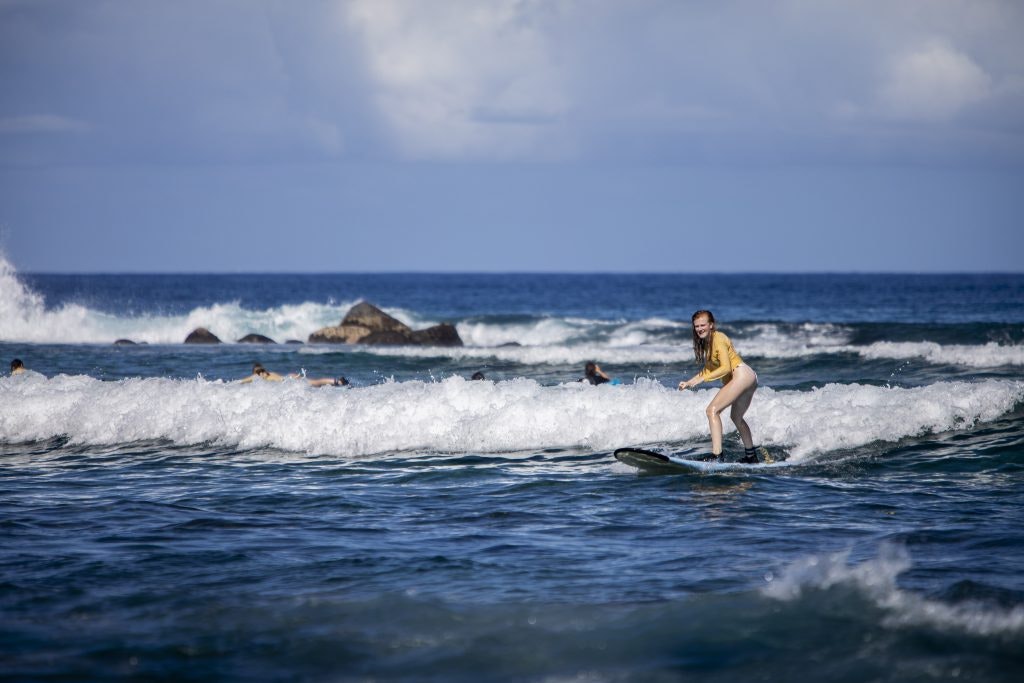2. You can see cold snow and warm sand on the same day in the Big Island
The Big Island, or the island of Hawai’i, is unique because it has 10 climate zones. These range from a humid tropical climate to arid conditions and even include some snow on the Mauna Kea and Mauna Loa volcanoes.
The largest dormant volcano in the world, Haleakalā, is a huge shield volcano and makes up a large part of Maui and also gets some snow dustings. This means you can wake up and enjoy a warm sandy morning on the beach and then take a hike in the afternoon to see snow on top of a mountain. There aren’t many places where you can do that.
It’s also important to remember that there are active volcanoes on the Big Island, including Kīlauea, Mauna Loa, Mauna Kea, and Hualālai. One of the most active volcano in the world is Kīlauea. A volcano is classified as active if it has erupted in the past 10,000 years.
Between 1912 and 2012, there were nearly 50 active volcano eruptions in Kīlauea, 12 in Mauna Loa, and one intrusion of magma in Hualālai.

Students exploring one of the many volcanos in Hawaii.
Magma intrusion occurs when molten rock from beneath the Earth’s crust pushes its way into cracks in the crust but does not reach the surface. This process often starts deep below the sea floor, where tectonic activity creates pathways for the magma to move upward through the Earth’s crust.
Here’s a quick volcanic tidbit: Kona coffee is grown on the slopes of the Mauna Loa volcano, where the coffee trees thrive in mineral-rich volcanic soil. High-quality beans from the trees are used to produce one of the most expensive coffees in the world, with the average price per pound of Kona coffee retailing at USD $20 to $30.
3. Hawaii is a land of geographical superlatives
If someone asked you to name the world’s tallest mountain, what would you say?
Mount Everest is a common response, but technically it’s not correct.
Mount Everest has the highest altitude. However, scientists have declared Mauna Kea on the island of Hawaiʻi as the tallest mountain. How is that true?
If you measure Mauna Kea from the North Pacific ocean floor to its height above sea level, it’s taller than Mount Everest. The famous mountain on Nepal’s and China’s border rises 29,032 feet. In comparison, Mauna Kea is only 13,796 feet above sea level, but it also extends about 19,700 feet below the sea. Add that together and the mountain is a whopping 33,496 feet tall.

Mountains like Mauna Kea in Hawaii are mostly underwater.
This isn’t the only superlative Hawaii can claim. The area of Ka Lae on Hawaii island is the southernmost point in all the 50 states. It’s commonly known as South Point.
Despite what many people think, Hawaii isn’t the most Western state though. Alaska takes the claim for that. Alaska’s Attu Island is the United States’ most western point.
4. The Hawaiian language is critically endangered
Hawaiian and English are the two official languages used in the state of Hawaii. Sadly, it’s estimated that there are only about 2,000 native Hawaiian speakers left.
Because of its limited use, UNESCO has classified Hawaiian as a critically endangered language. The decline in language speakers began in 1896 when English was established as the official language in Hawaiian schools. After the annexation of Hawaii by the United States in 1898, the Hawaiian language was officially banned from schools and state government, almost making it extinct.
Officials tried to turn the tide by adding language immersion preschools in 1984. In these schools, students were taught the Hawaiian language in hopes they’d carry the knowledge into their adulthoods.
What’s interesting is that Hawaiians had no written language prior to Western contact, except for petroglyph symbols. This oral language was passed down through songs and poems.
In the early 1800s Christian missionaries created a Hawaiian alphabet with 12 letters. It includes the five vowels, seven consonants (h, k, l, m, n, p and w) and the ‘okina symbol (‘) that’s written as a single quotation mark. It indicates a glottal stop.
The most common word you may hear in Hawaii is “Aloha.” It combines “Alo” for spirit or presence and “ha” for breath, so the word means much more than hello. When you say “Aloha,” you are in a way sending positive energy – a breath of life.
The language has been used to name many island locations. One example is the Kilauea volcano in Volcanoes National Park. Kilauea means “spewing.”
The language was also used to create the state motto, which is Ua Mau ke Ea o ka ʻĀina i ka Pono. This means, “The life of the land is perpetuated in righteousness.”
5. The Hawaiian religion still influences life today
The indigenous religious beliefs of ancient Hawaiians also faded after the arrival of Christian missionaries. In the 1800s some Hawaiian religious traditions were banned. Leaders spoke out against the “worshiping of idols,” which included elements in nature.
Still some religious traditions survived. Today, Hawaii is like other U.S. states with a mixture of religions practiced by its people. This includes some native Hawaiians who follow the traditional Hawaiian religion.
This religion is polytheistic and animistic. Its beliefs center on the presence of spirits in nature, such as the tides, the sky and volcanic activity. The religion has four key gods:
- Kāne – Creator and god of light
- Kanaloa – God of the ocean and winds
- Kū – God of war
- Lono – God of agriculture
The religion also has hundreds of other deities. They generally fall into two categories:
- Akua – Primarily gods of nature, such as snow, light, and the sea
- Aumakua – Personal or family god that originated as a deified ancestor
6. You need to watch what you grab in Hawaii if you want to avoid bad luck
The Hawaiians’ indigenous beliefs and their general respect for nature has led to some island rules. One of the biggest rule is a law forbidding the taking of lava rocks. Many people believe that if you grab rocks or sand from nature and take them home, you’ll have bad luck.
In fact, the staff at Hawaii Volcanoes National Park regularly receives letters from people apologizing for taking a rock back with them. The writers will return the rock in the envelopes of their letters since returning it is the only way of stopping the so-called Pele’s curse.
Pele is the goddess of fire and volcanoes. It’s said the lava rocks and sand are her children, and that she was infuriated when a traveler took a lava rock as a souvenir. She responded by placing a curse on the rock.
This led to the widespread curse that brings bad luck to anyone who removes a rock from Hawaii. Many Hawaiians consider the rocks sacred, and they’ll bring gifts to a volcano in hopes of getting good luck.
That said, many Hawaiians also believe the story of the curse was made up by park rangers to discourage tourists from taking rocks.
Regardless, nature is revered in Hawaii, so it’s wise to leave everything the way you found it. This shows respect for the Hawaiian belief that even inanimate objects have a life force or mana, so you should leave it be.
7. Hawaii is a fantastic destination for people who are afraid of snakes.
Hawaii is the perfect place for people with ophidiophobia. Yes, it’s a great word for a spelling bee, and it means an extreme fear of snakes.
Hawaii has no native land snakes. The only snakes you may find on land are tiny nonvenomous Brahminy Blind Snakes. They hitched a ride to Hawaii from the Philippines. To prevent other invaders, there are strict laws against snake ownership.
Rarely, Hawaii’s native yellow-bellied sea snake will be seen slithering through the water. But generally you’re unlikely to encounter a snake.
As an added bonus, Hawaii is considered rabies free. The state doesn’t have squirrels and pet gerbils and hamsters are banned. But you can see many native species of birds in Hawaii, along with the Hawaiian monk seal, Hawaiian hoary bat, whales and dolphins.
8. Hawaii has its own place in time.
If you live in the United States, you’re familiar with the continental time zones. You may have friends and family living in the four main zones – Eastern, Central, Mountain and Pacific Time.
Hawaii though is in the class of its own with a time zone that it only shares with a small portion of Alaska. These areas are located in the Hawaii–Aleutian Time Zone.
However, Hawaii doesn’t observe daylight saving time, so during certain times of year, the state is in its own time zone and will be on Hawaii Standard Time. Because of this, the state is two to three hours behind the Pacific Time Zone depending on the time of year.
9. Several Hawaiian islands have their own color and flower.
Hawaii’s state flower is the hibiscus brackenridgei, also known as the yellow hibiscus. Fun fact about this plant: it blooms almost daily but the bloom lasts for only a day.
Hawaiians treasure the fauna and flora that are abundant across the islands. To pay tribute, eight islands in Hawaii have an official flower and a color based on that plant. One exception is the island of Ni’ihau that uses a shell rather than a official plant or flower.
Here are the official designations:
![An infographic displaying the colors and flowers representing each of the Hawaiian Islands.]()
10. Many famous movies were filmed in Hawaii.
The scenery in Hawaii is a dream for many film directors, so numerous movies have been partially filmed on the islands. This list of movies filmed in famous locations includes:
- South Pacific (1958)
- Raiders of the Lost Ark (1981)
- Indiana Jones and the Kingdom of the Crystal Skull (2008)
- Avatar (2009)
- Hunger Games: Catching Fire (2013)
- The Jurassic Park movies (1993 – 2022)




